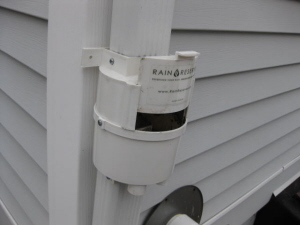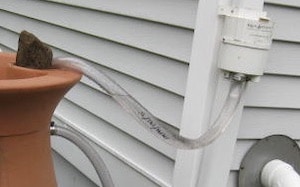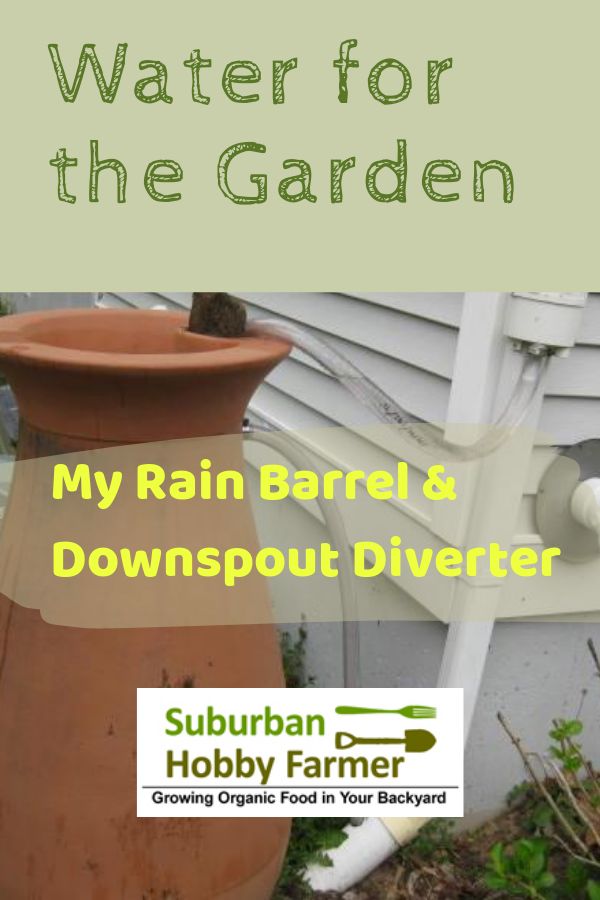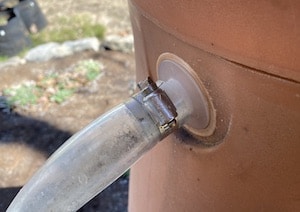Updated: July 19, 2022
An automatic downspout diverter routes water from your home’s gutter system into your rain barrel. This gives you an easy, cheap way to collect all the water that falls on your roof.
I’ve used the Rain Reserve Automatic Downspout Diverter for 10+ years, and it’s served me well. It has collected literally thousands of gallons of water.
Let’s take a sec to get the legal words out of the way. This article may contain affiliate links. That means if you click and buy from my partners, I will make a tiny amount of money. This in no way affects my recommendations.
But I’ve learned a lot in 10+ years, and I now recommend the Oatey Mystic Rainwater Collection System instead.
Now that I’ve used the Rain Reserve for a while, I’m can tell you how it’s performed compared to the Oatey diverter.
The bottom line is I like it (with a few caveats). I CAN’T give it an unrestricted thumbs up.
My recommendation is to buy an Oatey downspout diverter instead.
Here’s a really nice video of the Oatey unit set up.
Table of Content
This is a long, detailed article. You can jump to where you want to be by clicking on the different sections below. To come back to this table of contents, just use the back button on your browser.
Read the rest of the my review to avoid making the same initial mistakes I did.
Why an automatic downspout diverter?
Here in New England (and most places), downspout diverters are necessary for a couple of reasons.
First, you need a diverter because, once the rain barrel is full, you don’t want the excess water spilling next to your foundation. Why not? Because the water will drain into your basement.
After about 8 years the sun started to breakdown the plastic. This caused the diverter to crack.
— Suburban Hobby Farmer
Second, before winter sets in, you want to be able to remove the rain barrel. Otherwise, it will freeze and crack when the ice expands.
A diverter will allow you to remove and store the barrel. In fact, the gutter will function exactly as it did before installing the rain barrel.

Installation
Although it took me longer than the marketing materials suggested, I was able to install the Rain Reserve. And I’m not the most handy person when it comes to these types of things. In other words, it was easy.
Where I ran into trouble was lining up the height of the rain barrel and the diverter on the downspout.
Here’s how it’s supposed to work: When the barrel is full, the diverter sends the water automatically into the gutter system as if the diverter wasn’t there. This prevents the water from overflowing out of the barrel.
Level with the top of Barrel
But to make this work properly the level of the downspout must line up with the top of the barrel. If the barrel is too low, the water overflows and never goes into the gutter system. If too high, the water starts flowing out the gutter system and the barrel never fills to the top.
It worked perfectly when I first set it up. But over time the weight of the water packed down the dirt and dropped the level of the barrel below the level of the diverter. This caused the water to overflow the barrel instead of going down the downspout.

Harvest Water From Your Roof
All my articles on rain barrels and rain barrel downspout diverters.
I tried building up the height of the barrel with bricks. But it became painfully obvious that you couldn’t keep the level constant. It was going to change up or down no matter what I did.
My solution was to use a hose to connect the rain barrel overflow to the gutter system. So, when the barrel was full, the excess water routed back into the gutter system and away from my foundation. This was easier to implement than the way it was supposed to work.
Rain Reserve automatic downspout diverter: A couple of other issues
There also are a few other things to know about before buying this product.
First, the white hose that came with the Rain Reserve kit was pretty inflexible. This made it hard to connect to the barrel. I think the new kits now include a more flexible hose, so this may no longer be a problem.
Second, after a while, the caps that cover the drains inside the diverter have started to leak a little. This is the case no matter how tight I put them on. But the volume isn’t too bad. It only leaked a little.
This is the only thing that has worn out in the first three years. Pretty good by my estimation.
Third, after about eight years or so, the sun started to get to the plastic. The UV rays did some damage and the diverter cracked. It wasn’t enough to make it unusable, but enough to cause worry.
After about 12 years the diverter started to fall apart. Twelve years is a long time, but still, you want it to last for as long as you are living there.
The bottom line is buy a downspout diverter that is UV resistant, and you’ll have less to worry about.
Rain barrel diverter FAQ
Below are some of the most common questions I get about rain barrels and diverters:
What is a rain barrel diverter?
The diverter redirects water from your gutter drain pipe to a rain barrel. If you set it up properly, a rain barrel diverter also will automatically redirect excess water back to your gutter drain pipe when the rain barrel is full. In short, a rain barrel diverter automagically harvests water from your gutter system.
Why should you use a rain barrel diverter?
If you want an automatic rain collection system that will fill your rain barrel and not overflow, you should use a rain barrel diverter. Another very good reason to use a diverter is that most of them will allow you to disconnect the rain barrel in the winter by redirecting the water back through the original gutter.
What is the best rain barrel diverter?
When you consider costs and features, I believe that the Oatey downspout diverter is best. It’s made from UV RESISTANT PLASTIC and has a thread-able nozzle for a hose.
What happens when the rain barrel fills up?
If you are using a rain barrel diverter, when the barrel is full, it will force the water back through your gutter system. If you are not using a diverter water will flow out of the overflow spout if the rain barrel has one.
How does a rain barrel diverter make it easier to temporarily remove the rain barrel for cleaning or over the winter?
A diverter will allow you to disconnect the rain barrel because it will automatically route the water that was going to the barrel back through the gutter system. This is great when the barrel needs cleaning or in winter when you don’t want your barrel to freeze and crack.
How does a rain barrel diverter work?
This is a little complicated. When the rain barrel is not full, the diverter routes water from the down pipe to the barrel. When water in the barrel reaches the level of the diverter, the water pressure automatically stops the additional water from flowing into the barrel and forces it back through the gutter system. So your rain barrel has an automatic shut off.
Is a rain barrel worthwhile?
The cost effectiveness of a rain barrel would depend on your cost of water. If water is expensive, a rain barrel could pay for itself after 4 or 5 rain storms. Everything after the breakeven point is savings. If you have a well or live where water is cheap it will take time to realize savings. But there are other benefits. A rain barrel helps control erosion and therefor can improve surface water. It also reduces stress on water supplies.
Do rain barrel diverters help with drainage or erosion?
Because rain barrels capture much of the water that falls on your roof, they may prevent water run off or erosion and the associated pollution of the environment.
How quickly will a rain barrel diverter fill a rain barrel?
How fast a rain barrel fills depends on the size of the roof served by the gutter and how hard the rain falls. Most people are amazed at how quickly a rain barrel will fill even in a moderate rain storm. A 15-minute hard rain is often enough to fill a rain barrel if the roof is large enough.
What can I put in a rain barrel to stop mosquitoes?
The very best, organic method for stopping mosquitoes from using your rain barrel to multiply is a mosquito dunk. What are mosquito dunks? They are small round disks that contain a natural, organic ingredient that eats mosquito larvae. I know what you’re thinking: if it eats mosquito larvae, what does it do to plants, other insects, animals or people? But it’s completely harmless and safe.
What’s the most common problem with rain barrel diverters?
Backyard gardeners often find that the most common problem they come up against when using a rain barrel diverter is that it overflows and spills water next to their foundation. An overflowing rain barrel is usually caused by installing the diverter at a level above the top of the open top rain barrel. When this is the case, water just keeps going into the rain barrel and the diverter doesn’t do its job of diverting water back to the gutter pipe.
Will rain barrel diverters last as long as your gutters will?
If you buy a diverter that is made from UV RESISTANT PLASTIC, the diverter will last a long time. Maybe it won’t be as long as the gutters, but it will last as long as the life of the rain barrel.
How do you fix an overflowing rain barrel?
If the rain barrel diverter is positioned too high, an open top rain barrel will never redirect the water back to the gutter system. As a result, water will continuously overflow as long as it continues to rain. If your rain barrel has an overflow spout, you can fix the issue by running a hose from the overflow to the gutter system. This way, the rain barrel remains full but the excess water does not overflow.
Can you daisy chain rain barrels to capture more water?
Yes! You can add capacity to your rain harvesting system by running a hose from the overflow spout of your rain barrel to a second barrel. You can add as many rain barrels as you want by daisy chaining them together.
Do all rain barrels have overflow spouts?
Some rain barrels don’t have overflow spouts. But many do. Look to buy one that does.
Can you attach a hose to the faucet on a rain barrel?
Yes you can usually attach a hose to the faucet on a rain barrel. Most rain barrels have faucets with threads for this reason.
Are rain barrels environmentally friendly?
Rain barrels are good for the environment in two ways: First, you are not using water from underground aquifers or other sources where the water may be in short supply. Second, rain barrels prevent erosion and the associated environmental pollution by trapping the water and sending it to where it’s needed. However, some local governments have rules against rain barrels because they capture water that would otherwise contribute to municipal water supplies.
Is rain water better for plants than water from my faucet?
Rain water is typically higher in nitrogen than water from many municipal water supplies, and nitrogen is an important nutrient for your garden. Rain water also has less chlorine than most treated waters. Un-chlorinated water is better for plants.
Can I drink water from a rain barrel?
No! Never drink water from a rain barrel. It almost always contains contaminants that will be bad for your health or your pet’s health.
Should I put a rain barrel on a pedestal?
The height of the water barrel is very important. A rain barrel where the top of the barrel is below the downspout diverter will never direct water back to the gutter pipe when the open top barrel is full. So it will overflow as long as the rain continues. Also, if you use a hose to water directly from the barrel, the water level will need to be higher than the end of the hose. Otherwise, there will be no water pressure and water will not run from the hose. So you may or may not want to put your rain barrel on a pedestal. One more point: you must be sure that a pedestal is stable because a barrel gets very heavy and may break something if it falls.
At what height should I position the rain barrel diverter?
You should position the rain barrel diverter at the height where you want the level of water in your barrel. If you go too high, the diverter won’t shut off the water to the barrel when it is full. If you position it too low, your rain barrel won’t fill completely. Keep in mind, however, that barrels tend to settle over time. So it’s better to position the diverter too low than too high.
What’s the difference between an open top and closed top rain barrel?
An open top rain barrel is, as the name implies, open at the top. This is so you can clean the inside of the barrel. It also allows you to direct water into the top of the barrel, which is good for many rain water harvesting set ups. A closed top rain barrel has advantages, too. With a closed barrel, if you position your diverter above the barrel, it will send water back into the gutter system automatically when the barrel is full. This will continue to work even if the barrel settles lower, which is very likely.
Can I use a rain barrel without a downspout diverter?
Yes, with an open top rain barrel, you can direct the down pipe right into the barrel. But you have to have a system for dealing with the excess water when your barrel fills.
Do I need a pump for my rain barrel?
If you use gravity properly, you don’t need a pump to get the rain barrel water where it needs to go. In some cases, however, you might need a pump to get water to a higher elevation. Of course a pump will require excess electricity. This diminishes the eco advantages of a rain barrel.
My recommendation
I recommend that if you are in the market for a downspout diverter, you consider Rain Reserve.
But, keep in mind, many SHF readers have instead selected the Oatey over the Rain Reserve. They’ve told me that it is UV resistant and performed better.
Related article you might enjoy:
- Better Tomatoes with Walls-O-Water, Water Teepees or Whatever You Call Them
- Product Review: Neptune’s Harvest Liquid Fertilizer
- I Shopped for Hoop House Kits. A Review of the Three I Considered

Suburban Hobby Farmer is a participant in the Amazon Services LLC Associates Program, an affiliate advertising program designed to provide a means for sites to earn advertising fees by advertising and linking to amazon.com.
